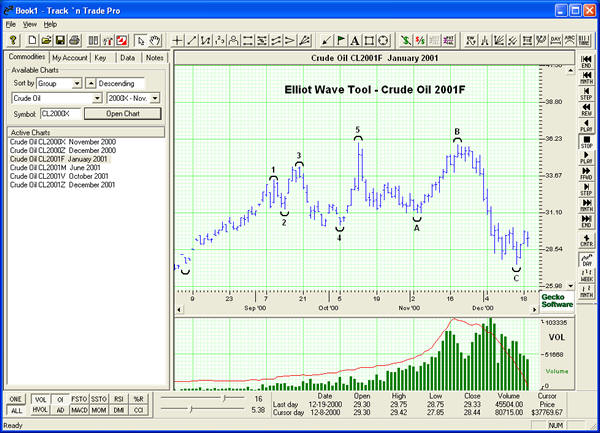![]()
Charting an Elliot Wave:
Resizing the Elliot Wave Drawing:
- Select the drawing by clicking on it.
Note: The drawing is selected when boxes appear on the corners.- Click on one of the boxes to drag the select point and release the mouse button.
Moving the Elliot Wave Drawing:
Select the drawing by clicking on it continue holding down the mouse button, drag to the new location and release the mouse button.
Deleting the Elliot Wave Drawing:
Select the drawing by clicking on it and press the delete key on your keyboard to remove.
Changing the Properties of a Elliot Wave Drawing:
- Right-Click on the drawing to view the properties menu. (see below)
- Properties that can be changed are:
- Foreground: Changes the line color of the Elliot Wave.
- Line Thickness: Changes the thickness of the Elliot Wave Line.
Choose values from 1-6.- Line Style: Changes The line style of the Elliot Wave Line. Choose from solid, dashed, dotted and more.
- Arc Thickness: Changes the arcs formed at the 1-5 and ABC points. Choose values from 1-6.
- Font: Changes the Font, Size, Style, and Color of the 1-5 and ABC points.
- Show Text: Select to view or hide the 1-5 and ABC points.
- Send to back: Changes the layer of the tool. This option is used when more than one tool is in the same area of the chart. Click on Send to Back when you need to access a tool under the Elliot Wave Drawing.
 |
Indicator Type:
Non-Indicator
Introduction:
This theory was developed by Ralph Nelson Elliot and bares his name. It is a
collection of theories on how a market acts and reacts. Elliott wave theory is
an idea that market behavior is based on waves rather than random timing.
Elliott believed that market prices rose and fell in a series of waves based on
the same Golden ratio or Golden mean that Fibonacci proved. This ratio is
present in many aspects of nature and science, and Elliott felt that it had
great significance on the financial markets as well.
Interpretation:
The basic idea of this theory is that a market rises in a series of 5 “waves” as
he called them. Also that a market declines in a series of 3 declines. Elliott’s
theory is that on the first wave a market rises, on wave two it declines, begins
again to rise on wave three, has a period of decline again on wave four, and
finally completes the rise on wave five. The period of correction is referred to
as a three-wave correction, where the market declines for wave A, begins to rise
for wave B, and falls again for wave C.
It is by this theory that Elliott believed that all market behavior corresponded
with either a 5 wave advance or a three wave decline. Elliot went on further to
explain that major chart advances and declines could be shown as a series of 5
and 3 wave cycles. He believed that a complete market cycle consisted of an 144
wave cycle, broken down into an 89 wave bull cycle, and a 55 wave bear cycle.
This is based on his observation of Fibonachi’s golden ratio.
The series of numbers Fibonacci describes, (1, 2, 3, 5, 8, 13, 21, 34, 55, 89,
144) shows a relationship of 1:.618. Elliot further showed that a market usually
rises or falls based on this wave cycle. Each wave in the cycle has its own
characteristics. The first wave is normally very short and easy to miss. Wave
number two, a retracement wave, usually gives back all or most of what the first
one gained. Wave 3 is usually very prominent, as it follows a period of what
appears as consolidation, most people trade this wave. The forth wave is noted
to be very intricate yet still a consolidation. One of Elliot’s main rules is
that in a 5-wave advance cycle, wave 4 can never overlap wave 1. Wave five in
commodities is often quite very active, yet at some point declines and leads to
the 3 wave corrective cycle. The first wave of the 3-wave cycle is normally seen
as a minor pullback, of wave 5 of the advance cycle. It is followed by the
second wave of the downtrend, and is often hard to spot but should result in a
third wave continuing down. The third and final wave of a 3 wave down trend is
usually quiet significant and many traders see this a selling opportunity.
Example:
